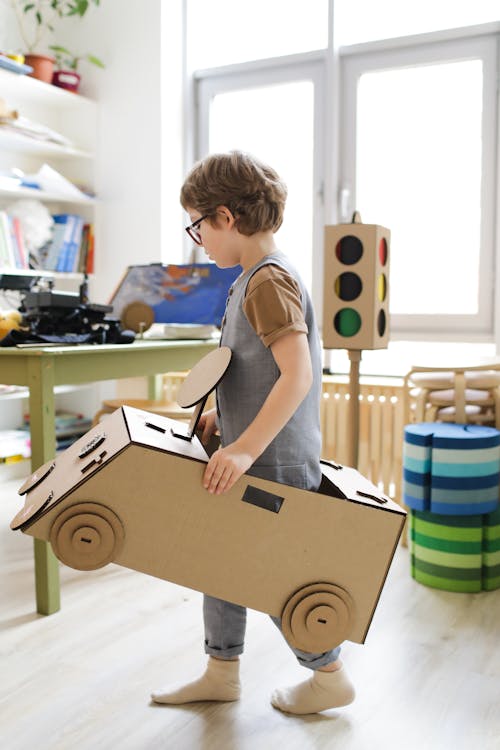Creative Kids Crafts: Fun for the Whole Family
There’s a unique joy in gathering around the kitchen table, hands sticky with glue and glitter, as laughter fills the room. Crafting with kids isn’t just about creating art; it’s about building memories, fostering creativity, and spending quality time together. Over the years, I’ve discovered that the simplest materials can lead to the most delightful projects. Let’s embark on a journey through some of our family’s favorite crafting adventures.
The Magic of Nature-Inspired Crafts
One sunny afternoon, we ventured into our backyard, collecting leaves, twigs, and pebbles. With these treasures, we crafted nature collages, arranging them on cardboard to create whimsical scenes. The textures and colors brought our artwork to life, and the process taught the kids to appreciate the beauty in everyday natural elements.
Another day, we tried our hands at making flower petal suncatchers. Pressing vibrant petals between contact paper and hanging them by the window transformed our living room into a kaleidoscope of colors. The sunlight filtering through the petals was mesmerizing, and the kids were thrilled to see their creations illuminated.
We also experimented with natural paintbrushes, tying leaves and grass to sticks. Dipping them into paint and swiping across paper resulted in abstract masterpieces, each stroke reflecting the unique shape of the brush. This activity not only sparked creativity but also connected the children to the tools they crafted themselves.
These nature-inspired crafts became more than just projects; they were lessons in observation, patience, and the wonders of the natural world. Each creation held a story, a memory of the day we spent together, immersed in creativity and nature.
Embracing Recycled Materials
One rainy afternoon, we gathered empty cereal boxes, toilet paper rolls, and bottle caps. With a bit of imagination, these items transformed into robots, castles, and even a miniature cityscape. The kids were amazed at how everyday trash could become treasured art pieces.
We also tried our hands at making juice pouch totes. Collecting used pouches, we cleaned them and stitched them together to create colorful, waterproof bags. The process taught the children about upcycling and the importance of reducing waste.
Another favorite was crafting with old magazines. Cutting out pictures and words, we created vision boards and story collages. This activity not only honed their cutting and pasting skills but also encouraged storytelling and goal setting.
Recycled crafts became a staple in our household, turning potential waste into cherished creations. These projects instilled a sense of responsibility and creativity, showing the kids that with a little imagination, anything is possible.
Seasonal Celebrations Through Crafts
As Easter approached, we explored mess-free egg decorating ideas. Using shaving cream and food coloring, we marbled plastic eggs, resulting in vibrant, swirled patterns. The kids loved the sensory experience, and the cleanup was surprisingly easy.
For Halloween, we crafted spooky lanterns from mason jars. Painting them with ghostly faces and placing LED candles inside, we lined our porch with these eerie lights. The neighborhood kids were impressed, and our children beamed with pride at their handiwork.
During the winter holidays, we made salt dough ornaments. Mixing flour, salt, and water, we rolled out the dough, cut out festive shapes, and baked them. Once cooled, the kids painted and glittered them, creating personalized decorations for our tree.
These seasonal crafts became traditions, marking the passage of time and adding a personal touch to our celebrations. Each ornament, lantern, or decorated egg held memories of laughter, creativity, and family bonding.
Classic Crafts with a Twist
Macaroni art was a childhood favorite of mine, and introducing it to my kids was a nostalgic experience. We glued pasta onto cardboard, creating intricate patterns and even spelling out names. Painting the dried pasta added a splash of color, making each piece unique.
We also delved into the world of mud pies. Setting up a mud kitchen in the backyard, the kids mixed soil and water, adding leaves and flowers to their concoctions. This messy play was not only fun but also encouraged sensory exploration and imaginative play.
Another twist on a classic was creating our own playdough. Mixing flour, salt, water, and food coloring, we kneaded the dough into vibrant colors. The kids sculpted animals, food items, and even miniature scenes, honing their fine motor skills and creativity.
Revisiting these classic crafts with modern twists kept the activities fresh and engaging. They bridged generations, connecting my childhood memories with my children’s experiences.
Incorporating Technology and Media
While we cherish hands-on crafts, we also embrace technology to inspire creativity. Watching shows like “Builder Brothers Dream Factory” introduced the kids to concepts of teamwork and problem-solving through imaginative stories. After episodes, they were eager to build their own creations using blocks and household items.
We also explored online tutorials for crafts, finding step-by-step guides for projects like origami animals and paper weaving. These resources expanded our crafting repertoire and introduced the kids to global art forms.
Using tablets, the children tried digital drawing apps, experimenting with colors and tools without the mess. This digital art complemented our physical crafts, offering a new medium for expression.
Integrating technology enriched our crafting experiences, blending traditional methods with modern tools. It opened up new avenues for creativity and learning, keeping the kids engaged and curious.
